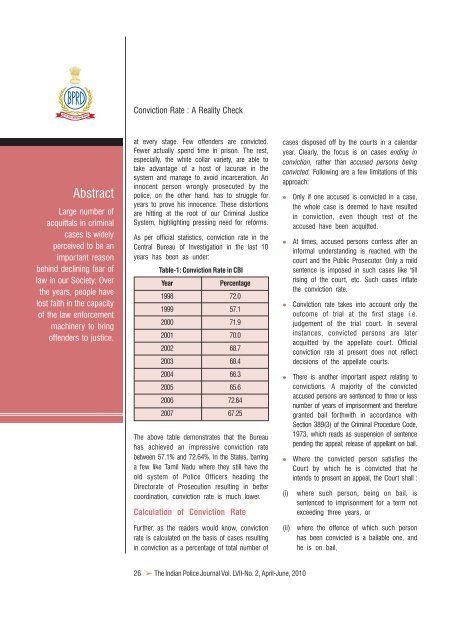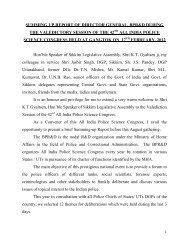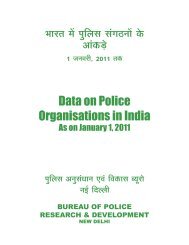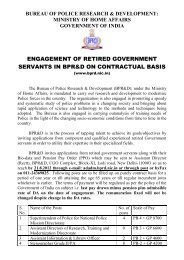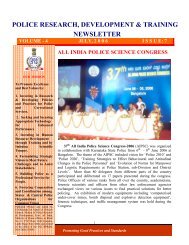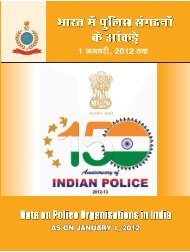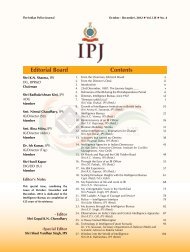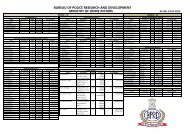April - June 2010 - Bureau of Police Research and Development
April - June 2010 - Bureau of Police Research and Development
April - June 2010 - Bureau of Police Research and Development
- No tags were found...
Create successful ePaper yourself
Turn your PDF publications into a flip-book with our unique Google optimized e-Paper software.
Conviction Rate : A Reality CheckAbstractLarge number <strong>of</strong>acquittals in criminalcases is widelyperceived to be animportant reasonbehind declining fear <strong>of</strong>law in our Society. Overthe years, people havelost faith in the capacity<strong>of</strong> the law enforcementmachinery to bring<strong>of</strong>fenders to justice.at every stage. Few <strong>of</strong>fenders are convicted.Fewer actually spend time in prison. The rest,especially, the white collar variety, are able totake advantage <strong>of</strong> a host <strong>of</strong> lacunae in thesystem <strong>and</strong> manage to avoid incarceration. Aninnocent person wrongly prosecuted by thepolice, on the other h<strong>and</strong>, has to struggle foryears to prove his innocence. These distortionsare hitting at the root <strong>of</strong> our Criminal JusticeSystem, highlighting pressing need for reforms.As per <strong>of</strong>ficial statistics, conviction rate in theCentral <strong>Bureau</strong> <strong>of</strong> Investigation in the last 10years has been as under:Table-1: Conviction Rate in CBIYearPercentage1998 72.01999 57.12000 71.92001 70.02002 68.72003 68.42004 66.32005 65.62006 72.642007 67.25The above table demonstrates that the <strong>Bureau</strong>has achieved an impressive conviction ratebetween 57.1% <strong>and</strong> 72.64%. In the States, barringa few like Tamil Nadu where they still have theold system <strong>of</strong> <strong>Police</strong> Officers heading theDirectorate <strong>of</strong> Prosecution resulting in bettercoordination, conviction rate is much lower.Calculation <strong>of</strong> Conviction Ratecases disposed <strong>of</strong>f by the courts in a calendaryear. Clearly, the focus is on cases ending inconviction, rather than accused persons beingconvicted. Following are a few limitations <strong>of</strong> thisapproach:(i)Only if one accused is convicted in a case,the whole case is deemed to have resultedin conviction, even though rest <strong>of</strong> theaccused have been acquitted.At times, accused persons confess after aninformal underst<strong>and</strong>ing is reached with thecourt <strong>and</strong> the Public Prosecutor. Only a mildsentence is imposed in such cases like 'tillrising <strong>of</strong> the court, etc. Such cases inflatethe conviction rate.Conviction rate takes into account only theoutcome <strong>of</strong> trial at the first stage i.e.judgement <strong>of</strong> the trial court. In severalinstances, convicted persons are lateracquitted by the appellate court. Officialconviction rate at present does not reflectdecisions <strong>of</strong> the appellate courts.There is another important aspect relating toconvictions. A majority <strong>of</strong> the convictedaccused persons are sentenced to three or lessnumber <strong>of</strong> years <strong>of</strong> imprisonment <strong>and</strong> thereforegranted bail forthwith in accordance withSection 389(3) <strong>of</strong> the Criminal Procedure Code,1973, which reads as suspension <strong>of</strong> sentencepending the appeal; release <strong>of</strong> appellant on bail.Where the convicted person satisfies theCourt by which he is convicted that heintends to present an appeal, the Court shall :where such person, being on bail, issentenced to imprisonment for a term notexceeding three years, orFurther, as the readers would know, convictionrate is calculated on the basis <strong>of</strong> cases resultingin conviction as a percentage <strong>of</strong> total number <strong>of</strong>(ii)where the <strong>of</strong>fence <strong>of</strong> which such personhas been convicted is a bailable one, <strong>and</strong>he is on bail,26 ➢ The Indian <strong>Police</strong> Journal Vol. LVII-No. 2, <strong>April</strong>-<strong>June</strong>, <strong>2010</strong>


